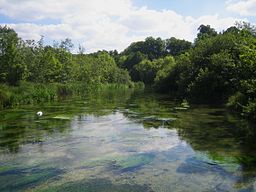River Itchen, Hampshire
|
Itchen |
|
|
The Itchen near Avington
|
|
| Country | England |
|---|---|
| County | Hampshire |
| Tributaries | |
| - left | Candover Stream |
| - right | Cheriton Stream |
| City | Winchester Southampton |
| Source | |
| - location | New Cheriton, Hampshire, England |
| Mouth | Southampton Water |
| - location | Southampton, Hampshire |
| - coordinates | 50°54′19″N 1°23′08″W / 50.9052°N 1.38565°WCoordinates: 50°54′19″N 1°23′08″W / 50.9052°N 1.38565°W |
| Length | 45 km (28 mi) |
| Basin | 400 km2 (154 sq mi) |
| Discharge | for Riverside Park |
| - average | 5.3 m3/s (187 cu ft/s) |
| - min | 1.75 m3/s (62 cu ft/s) 14 August 1995 |
| Discharge elsewhere (average) | |
| - Highbridge, Hampshire | 5.4 m3/s (191 cu ft/s) |
| - Easton, Hampshire | 4.3 m3/s (152 cu ft/s) |
The River Itchen (previously also known as the River Alre) is a river in Hampshire, England. It flows from mid-Hampshire to join with Southampton Water below the Itchen Bridge in the city of Southampton. The river has a total length of 28 miles (45 km), and is noted as one of the world's premier chalk streams for fly fishing, especially using dry fly or nymphing techniques. The local chalk in the earth provides excellent filtration and thus watercress thrives all along the Itchen valley in its once pristine, crystal clear waters, now affected by pollution by some farming practices. It is designated as a Site of Special Scientific Interest and is noted for its high-quality habitats, supporting a range of protected species including the endangered water vole,otter, brook lamprey and white-clawed crayfish.
The river is managed by the Environment Agency, whilst the Port of Southampton is the navigation authority for the tidal section below Swaythling.
During Roman Britain, the river may have been associated with the Celtic goddess Ancasta.
The origin of the name is thought to be ancient and pre-Celtic; the meaning is unknown. The settlement of Itchen Abbas on the river is given as Icene in the Domesday Book of 1086.
...
Wikipedia


